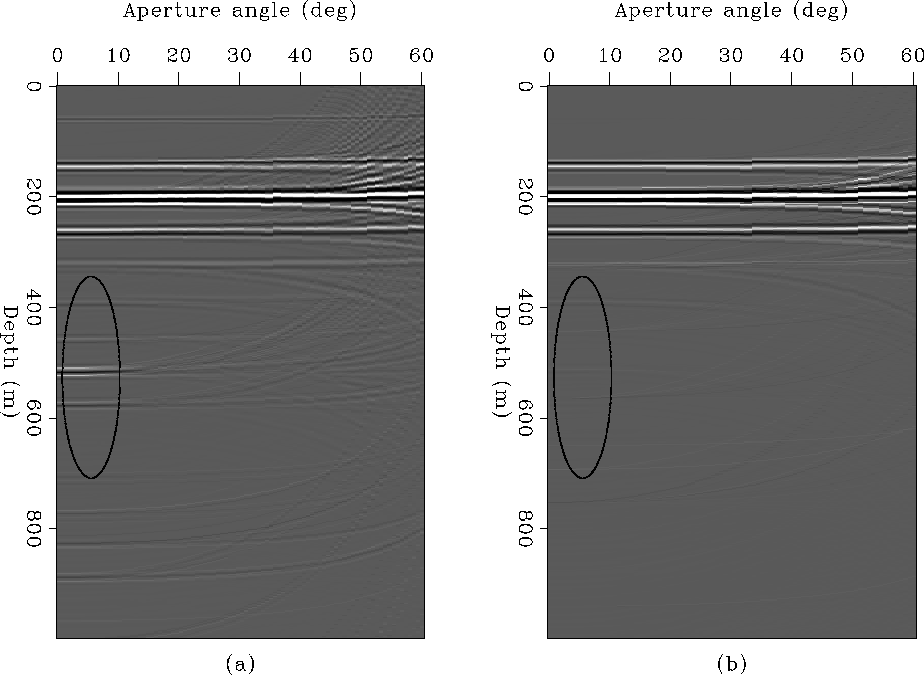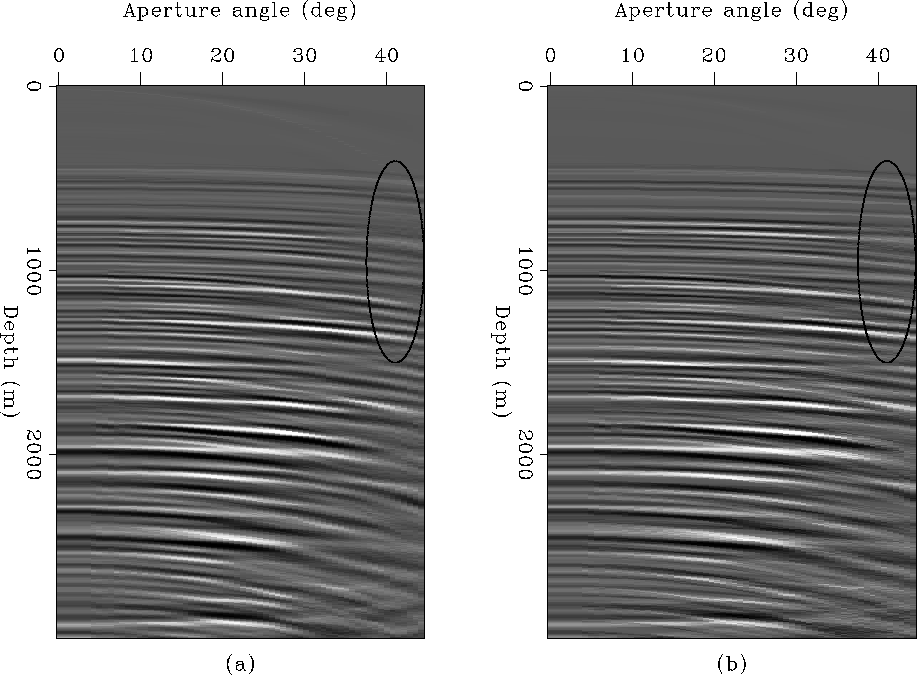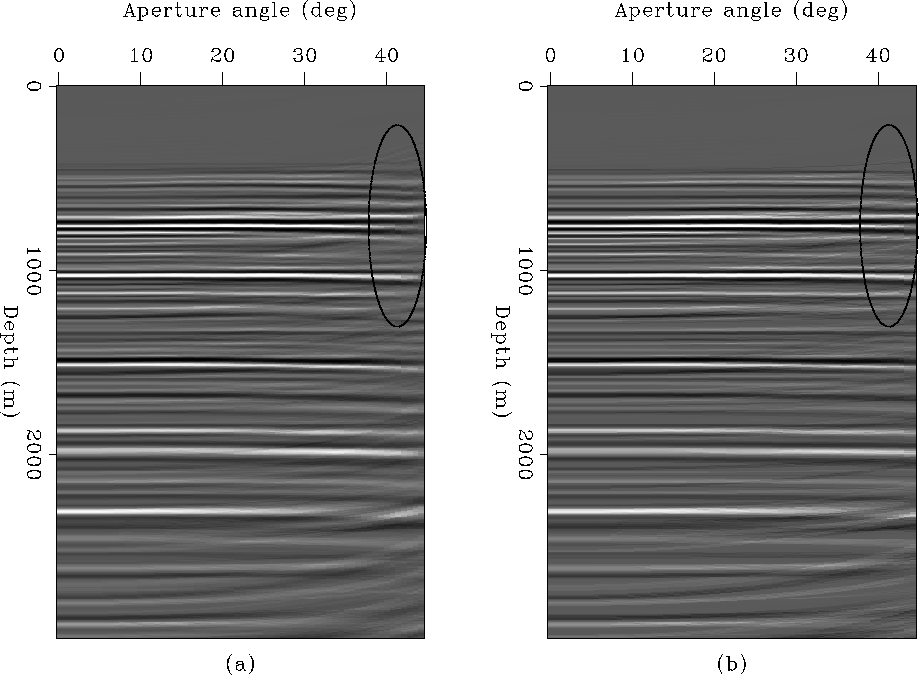




Next: Discussion and Conclusions
Up: Alvarez: Multiple attenuation
Previous: Comparison of Radon Transforms
In this section I examine the difference between the estimate of the multiples
and primaries obtained with the Radon transforms computed with both approximations.
I use the same ADCIGs from the previous section.
mul_comp1
Figure 6 Comparison of the multiple model for the synthetic
ADCIG of Figure ![[*]](http://sepwww.stanford.edu/latex2html/cross_ref_motif.gif) . Panel (a) shows the
multiples obtained with the straight-ray approximation and panel (b) the
multiples obtained with the ray-bending approximation.
. Panel (a) shows the
multiples obtained with the straight-ray approximation and panel (b) the
multiples obtained with the ray-bending approximation.




 prim_comp1
prim_comp1
Figure 7 Comparison of the primary model for the synthetic
ADCIG of Figure ![[*]](http://sepwww.stanford.edu/latex2html/cross_ref_motif.gif) . Panel (a) shows the
primaries obtained with the straight-ray approximation and panel (b) the
primaries obtained with the ray-bending approximation.
. Panel (a) shows the
primaries obtained with the straight-ray approximation and panel (b) the
primaries obtained with the ray-bending approximation.





Figure ![[*]](http://sepwww.stanford.edu/latex2html/cross_ref_motif.gif) shows the comparison of the multiple model estimated
with both transforms for the synthetic data shown in Figure
shows the comparison of the multiple model estimated
with both transforms for the synthetic data shown in Figure ![[*]](http://sepwww.stanford.edu/latex2html/cross_ref_motif.gif) .
The better focusing of the multiples in the Radon domain with the ray-bending
approximation translates into a slightly better estimate of the multiples,
especially at the
large aperture angles. Some weak residual primary still leaks into the multiples,
although with higher amplitude amplitude with the straight-ray approximation
(see the primary at 200 m). Figure
.
The better focusing of the multiples in the Radon domain with the ray-bending
approximation translates into a slightly better estimate of the multiples,
especially at the
large aperture angles. Some weak residual primary still leaks into the multiples,
although with higher amplitude amplitude with the straight-ray approximation
(see the primary at 200 m). Figure ![[*]](http://sepwww.stanford.edu/latex2html/cross_ref_motif.gif) shows the comparison of
the primary estimates. Again, a better result is obtained with the ray-bending
approximation. In particular, less energy from the multiples leaks into the primaries.
shows the comparison of
the primary estimates. Again, a better result is obtained with the ray-bending
approximation. In particular, less energy from the multiples leaks into the primaries.
Figure ![[*]](http://sepwww.stanford.edu/latex2html/cross_ref_motif.gif) shows the comparison of the multiple model for the real
dataset of Figure
shows the comparison of the multiple model for the real
dataset of Figure ![[*]](http://sepwww.stanford.edu/latex2html/cross_ref_motif.gif) . Notice that again, the new transform [panel (b)],
recovers a little better the multiple energy on the large aperture angles,
especially above 1000 m.
This energy will otherwise leak into the estimate of the primaries.
Finally, Figure
. Notice that again, the new transform [panel (b)],
recovers a little better the multiple energy on the large aperture angles,
especially above 1000 m.
This energy will otherwise leak into the estimate of the primaries.
Finally, Figure ![[*]](http://sepwww.stanford.edu/latex2html/cross_ref_motif.gif) shows the comparison of the primary estimate
with both transforms. Although the two panels look similar, careful examination of
the large aperture angles specially above 1000 m shows that the new transform
[panel (b)] has recovered the primaries better.
shows the comparison of the primary estimate
with both transforms. Although the two panels look similar, careful examination of
the large aperture angles specially above 1000 m shows that the new transform
[panel (b)] has recovered the primaries better.
mul_comp2
Figure 8 Comparison of the multiple model for the real
ADCIG of Figure ![[*]](http://sepwww.stanford.edu/latex2html/cross_ref_motif.gif) . Panel (a) shows the
multiples obtained with the straight-ray approximation and panel (b) the
multiples obtained with the ray-bending approximation.
. Panel (a) shows the
multiples obtained with the straight-ray approximation and panel (b) the
multiples obtained with the ray-bending approximation.




 prim_comp2
prim_comp2
Figure 9 Comparison of the primary model for the real
ADCIG of Figure ![[*]](http://sepwww.stanford.edu/latex2html/cross_ref_motif.gif) . Panel (a) shows the
primaries obtained with the straight-ray approximation and panel (b) the
primaries obtained with the ray-bending approximation.
. Panel (a) shows the
primaries obtained with the straight-ray approximation and panel (b) the
primaries obtained with the ray-bending approximation.










Next: Discussion and Conclusions
Up: Alvarez: Multiple attenuation
Previous: Comparison of Radon Transforms
Stanford Exploration Project
4/5/2006

![[*]](http://sepwww.stanford.edu/latex2html/cross_ref_motif.gif) . Panel (a) shows the
multiples obtained with the straight-ray approximation and panel (b) the
multiples obtained with the ray-bending approximation.
. Panel (a) shows the
multiples obtained with the straight-ray approximation and panel (b) the
multiples obtained with the ray-bending approximation.

![[*]](http://sepwww.stanford.edu/latex2html/cross_ref_motif.gif) . Panel (a) shows the
multiples obtained with the straight-ray approximation and panel (b) the
multiples obtained with the ray-bending approximation.
. Panel (a) shows the
multiples obtained with the straight-ray approximation and panel (b) the
multiples obtained with the ray-bending approximation.

![[*]](http://sepwww.stanford.edu/latex2html/cross_ref_motif.gif) . Panel (a) shows the
primaries obtained with the straight-ray approximation and panel (b) the
primaries obtained with the ray-bending approximation.
. Panel (a) shows the
primaries obtained with the straight-ray approximation and panel (b) the
primaries obtained with the ray-bending approximation.
![[*]](http://sepwww.stanford.edu/latex2html/cross_ref_motif.gif) shows the comparison of the multiple model estimated
with both transforms for the synthetic data shown in Figure
shows the comparison of the multiple model estimated
with both transforms for the synthetic data shown in Figure ![[*]](http://sepwww.stanford.edu/latex2html/cross_ref_motif.gif) .
The better focusing of the multiples in the Radon domain with the ray-bending
approximation translates into a slightly better estimate of the multiples,
especially at the
large aperture angles. Some weak residual primary still leaks into the multiples,
although with higher amplitude amplitude with the straight-ray approximation
(see the primary at 200 m). Figure
.
The better focusing of the multiples in the Radon domain with the ray-bending
approximation translates into a slightly better estimate of the multiples,
especially at the
large aperture angles. Some weak residual primary still leaks into the multiples,
although with higher amplitude amplitude with the straight-ray approximation
(see the primary at 200 m). Figure ![[*]](http://sepwww.stanford.edu/latex2html/cross_ref_motif.gif) shows the comparison of
the primary estimates. Again, a better result is obtained with the ray-bending
approximation. In particular, less energy from the multiples leaks into the primaries.
shows the comparison of
the primary estimates. Again, a better result is obtained with the ray-bending
approximation. In particular, less energy from the multiples leaks into the primaries.
![[*]](http://sepwww.stanford.edu/latex2html/cross_ref_motif.gif) shows the comparison of the multiple model for the real
dataset of Figure
shows the comparison of the multiple model for the real
dataset of Figure ![[*]](http://sepwww.stanford.edu/latex2html/cross_ref_motif.gif) . Notice that again, the new transform [panel (b)],
recovers a little better the multiple energy on the large aperture angles,
especially above 1000 m.
This energy will otherwise leak into the estimate of the primaries.
Finally, Figure
. Notice that again, the new transform [panel (b)],
recovers a little better the multiple energy on the large aperture angles,
especially above 1000 m.
This energy will otherwise leak into the estimate of the primaries.
Finally, Figure ![[*]](http://sepwww.stanford.edu/latex2html/cross_ref_motif.gif) shows the comparison of the primary estimate
with both transforms. Although the two panels look similar, careful examination of
the large aperture angles specially above 1000 m shows that the new transform
[panel (b)] has recovered the primaries better.
shows the comparison of the primary estimate
with both transforms. Although the two panels look similar, careful examination of
the large aperture angles specially above 1000 m shows that the new transform
[panel (b)] has recovered the primaries better.

![[*]](http://sepwww.stanford.edu/latex2html/cross_ref_motif.gif) . Panel (a) shows the
multiples obtained with the straight-ray approximation and panel (b) the
multiples obtained with the ray-bending approximation.
. Panel (a) shows the
multiples obtained with the straight-ray approximation and panel (b) the
multiples obtained with the ray-bending approximation.

![[*]](http://sepwww.stanford.edu/latex2html/cross_ref_motif.gif) . Panel (a) shows the
primaries obtained with the straight-ray approximation and panel (b) the
primaries obtained with the ray-bending approximation.
. Panel (a) shows the
primaries obtained with the straight-ray approximation and panel (b) the
primaries obtained with the ray-bending approximation.